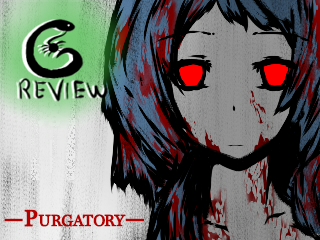Hello, annoying little internet flies. Your disgusting spider from moldy houses and your slimy snake from the smelliest sewers are ready to return here in the Archives to start this new season more charged than ever and ready to release our poisons.
The first review of this site was a very pissed off with a lot of flame in the background, then we continued with another not too positive review and this would perhaps indicate that our fate involves feeling anger in life. Perhaps some of you will have got used to our attitude…
Why are we talking about it now? Simple! Because with Back To The Future we are approaching the generation of the story-telling focus!
And that is precisely why we will resume our activities by reviewing Purgatory…
Yes, it has to do with everything. It has something to do with everything.
Purgatory is a really good game that we discovered this year, so why are we talking like we’re possessed by Satan?
Understand one thing.
The discourse of videogame narrativity, how this is perceived by a fandom and many other discourses related to it … It is really a macro-theme to deal with, a tough row to hoe for us.
All the articles scheduled until this spring will cover this topic, if not all of them. Let’s say almost everyone apart from one will come across this topic, they are simply divided into three different sections because we have found a way to dissect this year’s big theme through numerous analyzes of other games, for better…
…And for worse.
What we are approaching is not only about writing, but as we have already anticipated also the history of the various productions of these games. You will realize how the subjects change from those we have presented so far in Back to The Future. The world of Horror RPGs, and why not, of independent videogame production is about to change.
Now we can finally introduce what role this year’s “Reviews” category will play in all this. Therefore, three out of four reviews will deal with games that seem to approach the structure of Generation 0, which we remember was the Generation in which each game, even before trying to emerge, tried to convey sensations to the player.
Even if it is “only” fear, everyone has tried to do it in their own way, continuously looking for a style and numerous and varied methods …

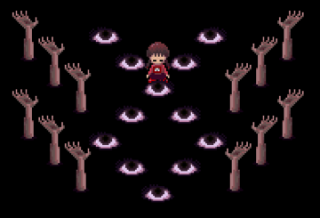

(In the pictures: Ao Oni, Yume Nikki, Body Elements)
…To try to convey something so primordial.
The reviews section will be really important at this time, because it will be our ground of comparison with the titles analyzed in Back To The Future and also with the title that we will analyze in a very special way not in a normal review or in the Back section To The Future, but in the new rubric…
So now that we’ve made our further introductions we can finally get closer to the title in question.
Purgatory
Plot
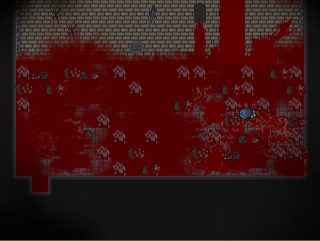
The game starts in a room full of corpses and blood where our protagonist falls. The design may not be the most eye-catching or well-finished, but like a good old-fashioned RPG Horror, it can introduce you to the action in a few minutes.
From the first exploration it appears to be a prison basement. Well, it is actually a prison.
The truth is that, as we will see by continuing the exploration, it is a slaughterhouse. The chosen setting was made in a very special way as the gray and dark palettes mix with the floors covered with flesh and walls of flesh that immediately trigger strong feelings of disorientation and desolation.
With the first rounds of exploration with Ele I was almost led to believe, given the scenario, that it was a sort of dystopia and for this I admit that I was a bit disappointed when in the end it turned out to be just an abandoned structure that the characters involved found themselves exploring out of pure curiosity.
We’ll know the explanation of how Enri (the name of our protagonist) ended up there little by little with flashbacks. The way in which the first flashback happens is clear, as the girl moves to the next area we see her in a different environment and with different clothes, while we are then introduced to Emma, one of the kids who will push her to enter the facility first. to make her search the place.
We said this environment looks like a butcher’s shop …
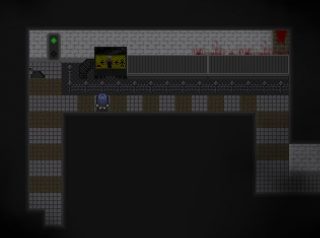
…With a machine to cut the meat into slices.
And if it’s a slaughterhouse, a butcher couldn’t be missing.

Among the various game overs and bad ends will also include an ending in which Enri will be able to get out using the tool of a strange ax that will give her a demonic status with which she can defeat him and escape.
In reality, I wouldn’t have much to say about the story, there isn’t a plot to unravel and with which I can get my hands dirty. What matters in this game is suggestiveness.
The author managed to bring to the public a game so suggestive that it deserves an equally complex plot. Even if the few events that are told to us are clear and told with transparent linearity, these unfortunately would not be enough to be able to boast the construction of a valid narrative plot, without neglecting the numerous background elements that there would be to explain and I’m not so sure that a Purgatory 2 could do so.
However, I do not totally disdain the type of plot we came across, especially since this makes the supernatural oddities that arise along the way even more evocative. With a little effort, it would probably be possible to build on a good narrative framework that can explain the phenomena we observe during gameplay without having to give up their elusive and paranormal nature.
The next game we will review we will find ourselves in front of a more interesting and multifaceted case of videogame storytelling in the clues to be grasped during the exploration of the environment …
Speaking of this, it is appropriate to leave the article in Ele’s hands.
Yes, I admit that you spent very little time with me during this article, but with you we will have the opportunity to see each other in the next ones.
You will see me, you will see me…
Gameplay
Good evening! Good evening! It is Ele (or EleRantula if you prefer) now that speaks to you!
What can I say… Paola has more or less summarized part of what I will say in this part of the review:
“… Like a good old-fashioned Horror RPG, it can introduce you to the action in a few minutes.”
Yes, as we said for The Crooked Man in Back To The Future, here too we have a return to the Horror Experience Generation.
But if in the title of Uri it seems that we only had a jolt of this generation, since it was mainly given by the atmosphere of the game, in Purgatory we can have a nice full-immersion in this generation, albeit in a more “modern” key.
Now you will understand what I mean, with a key question you might ask yourself:
“Why do you think a 2017 game has such great inspiration from a current of HOR-RPG that started practically in the mid 90’s?”
Guys, it will be a common answer, but just play.
The start of the game, as my sister told you, catapults you directly into the action.
No introduction of the background (for now) or of a particular situation by any means, an unknown and above all silent protagonist …
But let’s get away from those mountains of corpses and explore the place where the girl was taken so suddenly.
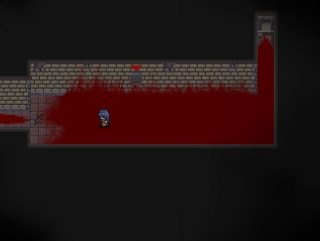
…………………

…………..
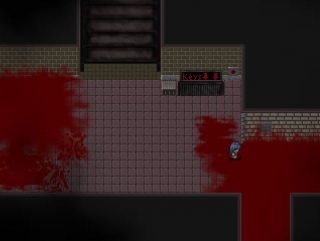
……………
During the exploration, do you not hear a certain… Silence?
No precise OSTs to accompany us in the horror atmosphere of this prison / butchery subspecies, only ambient sounds and the occasional (more frequent in the early stages of the game) Enri’s steps in the various lakes and pools of blood (which, if we want be very meticulous, at the level of realisticness I found exaggerated, even if they help a lot to build the atmosphere) present … This sense of peace, also given by the fact that, in fact, Enri seems to be a mute girl (or, if not, very taciturn ) so her point of view isn’t really shown through thoughts or dialogues ...
What does it make you feel?
As always, I tell you: isolated. As isolated from the rest of the world like Enri, since you are locked in there with her. This complete participation and immersion on the part of the player in the environment and atmosphere … Does it remind you of something, longtime fans?
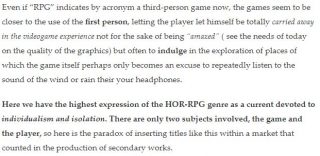
For those new to the Ludi Tarantula Archives, this text is taken from the article dedicated to Ao Oni in the “Back to the Future” section. We treated Ao Oni it in the so-called “Generation 0” that I am talking about so much in this review. There is more information on this in the very first Back To The Future article on CORPSE-PARTY, but even just reading this review you will have understood what kind of titles we are talking about.
So yes, ladies and gentlemen, we can confirm that in 2017 a title came out that seems very inspired by the atmosphere of about … How much, twelve years ago?
Moving on to the actual gameplay, this too is partly a consequence of this great inspiration from the Horror Experience generation.
In fact, in the game you have a pure exploration of the various environments, no precise puzzles but more than anything else a finding of objects to move forward, even if obviously you never find yourself in too dispersive environments, being the “butcher’s” sectioned into various environments always precise with some difference between them, divided by shutters that must be opened each time to progress in the game.
As they say, you don’t change a team that wins: even with this rather simple basic gameplay, Purgatory is not boring at all and Nama (author of the game) has almost always managed, especially from the second section onwards, to find imaginative ideas to let players find the “green keys” they need from start to finish.
But now let’s talk about the reason why at the beginning of this part of the review I mentioned a full-immersion in Generation 0 in a modern way. These that I will list will be precisely the reasons why this title in 2017 (and in 2020) holds up very well, despite being inspired by very old titles and while not being some kind of cult: linearity.
As I said above, the butchery is divided into various areas which in turn are divided into smaller areas (the various rooms within a macro-area, in short), which we do not have all available immediately: we have to unlock them one at a time.
Already compared to Ao Oni, where we have a nice multitude of rooms available from the beginning, or even Akemi Tan, this small element adds to Purgatory a type of procedure in the game more similar, for example, to the early stages of Ib.
Ib is from Generation 1: The Character Drama.
But in addition to puzzles and traps … We have said that in this butcher’s shop there is also a butcher. In fact, this title also includes a number of chases with this very nice meat-slicer, ready to kill us (as the slasher horror films say since the 80s).
Also from this point of view Purgatory moves away from titles like Ao Oni, where the chases are random and the Oni can appear from any angle, because the chases with the butcher are all scripted.
What is to be noted is not the very fact that the player knows when exactly the butcher appears, but the fact that scripted chases are typical of more driven games and with much more “plot dictated” chases; Purgatory could handle chases like Ao Oni, since the main enemy almost never has anything to do with the story, so whether it appears randomly or just and only at certain times it wouldn’t make much difference.
But it didn’t, and it was also a good choice, in my opinion. It made it easier to create imaginative ways to escape from… That massive man.
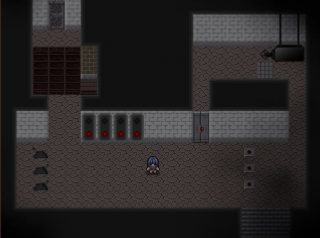
This case, for example.
This little … “Puzzle”? In short, it consists of pulling one of the levers and going to the corresponding button (which will be visible through the fact that it is a brighter red) as quickly as possible: if the player does not make it in time, the lever must be pulled again.
Here, after solving the riddle in this quieter room and having rigorously saved before entering the door that will take us to the next room, this happens.
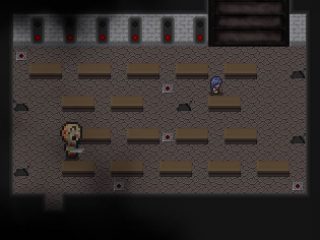
The player thinks: “Oh yeah, I have to do this like I did before!”
I really enjoyed this chase: many times when there are these types of chases (or even actual boss fights), they seem much more difficult than normal fights… But simply because it is very likely that the player will take longer to understand what the heck do they have to do in order not to be killed, than actually do it. And it’s… Annoying.
This chase, I tell you, was long enough for me. But I knew what I had to do, it was the actual difficulty of the chase that made it long and even at times complicated, given the added difficulty of the butcher who, in fact, chases Enri who in the meantime has to go from one button to another, from one lever to another…
So, citing this case, in short I appreciated the Purgatory chases in general, and the choice of making them scripted, which in many other games (such as Yume Nikki: Dream Diary) makes everything much more boring, predictable, and even anticlimatic, in this case it was a winner, given the general creativity there was for the game from a gameplay point of view.
Another thing that certainly makes the game more enjoyable to some kind of players, even if there are all those elements of gameplay and atmosphere of the constantly mentioned Generation 0, to explain the plot (why Enri ended up in the butcher shop, mainly), flashbacks are used in the form of cutscene, with obviously have also an alternative potrait for Enri to show what she was like before falling into that bad situation.
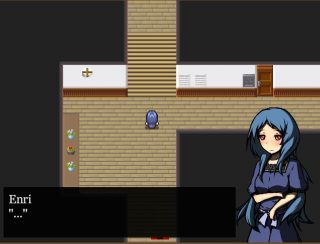
This scene, which you get when you are about to go to the second game zone, is also accompanied by music. There is the presentation of another character (Emma), who we will see in the following cutscenes and will be recognized for her false innocence and sneakiness, which will then be one of the main reasons (if not THE main reason) why Enri is in the Butcher’s shop.
During these scenes it can be seen that a story, however simple, is being told in all respects. There is not an introduction just to explain where we are, like in Ao Oni, but events told with potraits that also vary in expression (in some games this characteristic is absent, so I think it seemed right to say it). These are all small features that help to give a more precise context to everything we are doing with Enri in the present day and it helps a lot not to leave us that feeling of emptiness that you normally feel while playing a title of the generation from which the gameplay of this game takes inspiration.
Therefore Purgatory, for these reasons, is a really good title for the nostalgic of the Horror Experience that the puzzle solving phases of Ao Oni brought us in 2004, or even the first phases of Akemi Tan in 2012, along with other minor titles. (I take Body Elements as an example, with Kona5 as a developer) but at the same time, through some pretty good artwork and a small sufficiently logical background added to everything, it manages to be more enjoyable than other titles of the same type even for players more used to more linear games from the point of view of the storyline and gameplay, therefore also to the most novice Horror RPG players.
We can therefore define this title as “A piece of the past inserted into modernity”.

